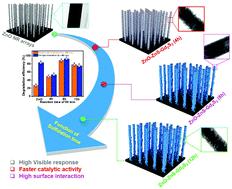Our official English website, www.x-mol.net, welcomes your feedback! (Note: you will need to create a separate account there.)
A radially controlled ZnS interlayer on ultra-long ZnO-Gd2S3 core-shell nanorod arrays for promoting the visible photocatalytic degradation of antibiotics.
Nanoscale ( IF 6.7 ) Pub Date : 2020-06-04 , DOI: 10.1039/d0nr03094e Kugalur Shanmugam Ranjith 1 , D Ranjith Kumar , Seyed Majid Ghoreishian , Yun Suk Huh , Young-Kyu Han , R T Rajendra Kumar
Nanoscale ( IF 6.7 ) Pub Date : 2020-06-04 , DOI: 10.1039/d0nr03094e Kugalur Shanmugam Ranjith 1 , D Ranjith Kumar , Seyed Majid Ghoreishian , Yun Suk Huh , Young-Kyu Han , R T Rajendra Kumar
Affiliation

|
Nanorod (NR) arrays offer commendable visible-light-driven photocatalytic performances. Herein, we describe the construction of a ternary ZnO–ZnS–Gd2S3 nanostructural array in which a sulfidation process is used to decorate a Gd2S3 shell layer with a ZnS interface over vapor-phase-grown vertically-aligned ZnO. With control over the shell-wall thickness, the shell layer of ∼25 nm wall thickness on the ultra-long ZnO NR arrays exhibited a higher catalytic efficiency close to 3.3, 2.0, 1.2, and 1.8 times those of the bare ZnO, the ZnO–ZnS, the Gd2S3-decorated (∼10 nm) and Gd2S3 shell-layered (∼40 nm) ZnO–ZnS core–shell structures, respectively. The core–shell geometry and the shell-wall thickness with maximized contact interface afforded increased light absorption in the visible region and effectively retarded the recombination rate of the photoinduced charge carriers by confining electrons and holes separately, thus providing advantages in terms of the degradation of the pharmaceutical residue tetracycline and the industrial pollutant 4-nitrophenol in wastewater.
中文翻译:

在超长ZnO-Gd2S3核-壳纳米棒阵列上的径向控制ZnS中间层,用于促进可见光降解抗生素。
纳米棒(NR)阵列提供了值得称赞的可见光驱动的光催化性能。在这里,我们描述了三元ZnO–ZnS–Gd 2 S 3纳米结构阵列的构造,其中采用硫化工艺在气相生长的垂直排列的ZnO上装饰具有ZnS界面的Gd 2 S 3壳层。通过控制壳壁厚度,超长ZnO NR阵列上约25 nm壁厚的壳层显示出更高的催化效率,接近裸ZnO ZnO的3.3、2.0、1.2和1.8倍-ZnS,修饰的Gd 2 S 3(〜10 nm)和Gd 2 S 3壳层状(约40 nm)的ZnO-ZnS核-壳结构。核-壳的几何形状和具有最大接触界面的壳-壁厚度提供了在可见光区域的增加的光吸收,并通过分别限制电子和空穴来有效地阻止了光致电荷载流子的复合速率,因此在降解方面具有优势。废水中的药物残留四环素和工业污染物4-硝基苯酚。
更新日期:2020-07-09
中文翻译:

在超长ZnO-Gd2S3核-壳纳米棒阵列上的径向控制ZnS中间层,用于促进可见光降解抗生素。
纳米棒(NR)阵列提供了值得称赞的可见光驱动的光催化性能。在这里,我们描述了三元ZnO–ZnS–Gd 2 S 3纳米结构阵列的构造,其中采用硫化工艺在气相生长的垂直排列的ZnO上装饰具有ZnS界面的Gd 2 S 3壳层。通过控制壳壁厚度,超长ZnO NR阵列上约25 nm壁厚的壳层显示出更高的催化效率,接近裸ZnO ZnO的3.3、2.0、1.2和1.8倍-ZnS,修饰的Gd 2 S 3(〜10 nm)和Gd 2 S 3壳层状(约40 nm)的ZnO-ZnS核-壳结构。核-壳的几何形状和具有最大接触界面的壳-壁厚度提供了在可见光区域的增加的光吸收,并通过分别限制电子和空穴来有效地阻止了光致电荷载流子的复合速率,因此在降解方面具有优势。废水中的药物残留四环素和工业污染物4-硝基苯酚。


























 京公网安备 11010802027423号
京公网安备 11010802027423号